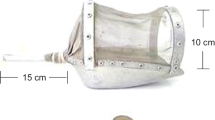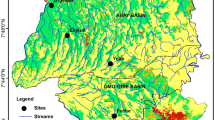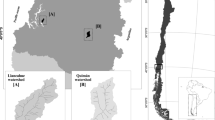Abstract
This study aimed to compare the efficiency of two different sizes of the Surber sampler to assess benthic macroinvertebrates in headwater streams in two Amazonian regions. Two Surber samplers of different sizes were used, one measuring 20 × 20 cm and the other 30 × 30 cm, both with a 0.25-mm net. The number of replicates taken was 6 for the smaller sampler and 3 for the bigger one, maintaining approximately the same total sampled area. The study was carried out in 12 headwater streams with different environmental conditions. Biological metrics were calculated for each size at each site and compared within each stream health category. A two-way analysis of similarities test was performed to compare the community structure assessed by each method at each stream. A normalized sampling effort was used to quantify the number of samples required to correctly sample each site. The data did not show a significant difference between the two sizes regarding the taxonomic recruitment and the community structure sampled at each stream, but differences were found between the two sizes in dominance values and in Shannon index scores for the natural sites. Furthermore, the smaller Surber was able to assess 70% of the estimated richness in all sites, which suggests that it is better to assess benthic macroinvertebrates than the larger Surber. Moreover, the smaller Surber is easier to transport in the field, reducing the effort of the technician, and takes less time to sort the material collected with it, which can reduce the sample processing effort, therefore reducing the cost of the project.


Similar content being viewed by others
Data availability
Not applicable.
References
Becerra-Jurado, G., Materson, M., Harrington, R., & Kelly-Quinn, M. (2008). Evaluation of sampling methods for macroinvertebrate biodiversity estimation in heavily vegetated ponds. Hydrobiologia, 597, 97–107. https://doi.org/10.1007/s10750-007-9217-8.
Bevilacqua, M. S., Marchese, M. R., Felix, R. W., Leal, J. J. F., Figueiredo-Barros, M. P., Bozelli, R. L., & Esteves, F. A. (2020). Aquatic oligochaete communities in Amazonian streams, Saracá-Taquera National Forest, Pará, Brazil. Biota Neotropica, 20(1). https://doi.org/10.1590/1676-0611-bn-2018-0654.
Brasil. (2005). Resolução CONAMA n°357 de 17 de março de 2005: Diário Oficial da União 18 de março de 2005, 58–63.
Bryant, R. (2015). The international handbook of political ecology. Edward Elgar. https://doi.org/10.4337/9780857936172.
Burrial, A. T., & Ocharan, F. J. (2007). Comparación del muestreo de macroinvertebrados bentónicos fluviales con muestreador surber y con red manual en ríos de Aragón (NE Península Ibérica). Limnetica, 26(1), 13–24.
Buss, D. F., & Borges, E. L. (2008). Application of rapid bioassessment protocols (RBP) for benthic macroinvertebrates in Brazil: comparison between sampling techniques and mesh sizes. Neotropical Entomology, 37(3), 288–295.
Buss, D. F., Daren, M. C., Tae-Soo, C., Culp, J., Harding, J. S., Keizer-Vlek, H. E., Robinson, W. A., Strachan, S., Thirion, C., & Hughes, R. M. (2015). Stream biomonitoring using macroinvertebrates around the globe; a comparison of large-scale programs. Environmental Monitoring and Assessment, 187, 4132. https://doi.org/10.1007/s10661-014-4132-8.
Cao, Y., Hawkins, C. P., & Storey, A. W. (2005). A method for measuring the comparability of different sampling methods used in biological surveys: implications for data integration and synthesis. Freshwater Biology, 50, 1105–1115. https://doi.org/10.1111/j.1365-2427.2005.01377.x.
Carter, J. L., & Resh, V. H. (2001). After site selection and before data analysis: sampling, sorting, and laboratory procedures used in stream benthic macroinvertebrate monitoring programs by USA state agencies. Journal of the North American Benthological Society, 20, 658–682.
Cho, W. S., Park, Y. S., Park, H. K., Kong, H. Y., & Chon, T. S. (2011). Ecological informatics approach to screening of integrity metrics based on benthic macroinvertebrates in streams. Annales de Limnologie - International Journal of Limnology, 47, S51–S62. https://doi.org/10.1051/limn/2011019.
Colwell, R. K. (2013). EstimateS: statistical estimation of species richness and shared species from samples. Version 9.1.0. User’s guide and application published at: http://purl.oclc.org/estimates.
Couceiro, S. R. M., Hamada, N., Forsberg, B. R., Pimentel, T. P., & Luz, S. L. B. (2012). A macroinvertebrate multimetric index to evaluate the biological condition of streams in the Central Amazon region of Brazil. Ecological Indicators, 18, 118–125. https://doi.org/10.1016/j.ecolind.2011.11.001.
Cunha, L. L., Alves, M. I. B., Ono, E. R., & Uieda, V. S. (2019). Métodos de amostragem de invertebrados bentônicos em ambientes lóticos: uma avaliação espacial e temporal. Acta Limnologica Brasiliensia, 31, e4. https://doi.org/10.1590/s2179-975x3917.
De Lima, M. G., & Gascon, C. (1999). The conservation value of linear forest remnants in central Amazonia. Biological Conservation, 91(2–3), 241–247.
Doberstein, C. P., Karry, J. R., & Conquest, L. L. (2000). The effect of fixed-count subsampling onmacroinvertebrate biomonitoring in small streams. Freshwater Biology, 44, 355–371.
Feeley, H. B., Woods, M., Baars, J. R., & Kelly-Quinn, M. (2012). Refining a kick sampling strategy for the bioassessment of benthic macroinvertebrates in headwater streams. Hydrobiologia, 68, 53–68. https://doi.org/10.1007/s10750-011-0940-9.
Friberg, N., Sandin, L., Furse, M. T., Larsen, S. E., Clarke, R. T., & Haase, P. (2006). Comparison of macroinvertebrate sampling methods in Europe. Hydrobiologia, 566, 365–378. https://doi.org/10.1007/s10750-006-0083-6.
Fryirs, K. A., & Brierley, G. J. (2012). Geomorphic analysis of river systems: an approach to reading the landscape. Wiley-Blackwell.
Ghani, W. M. H. W. A., Rawi, C. S. M., Hamid, S. A., & Al-Shami, S. A. (2016). Efficiency of different sampling tools for aquatic macroinvertebrate collections in Malaysian streams. Tropical Life Sciences Research, 27(1), 115–133.
Jun, Y. C., Kim, N. Y., Kwon, S. J., Han, S. C., Hwang, I. C., Park, J. H., Won, D. H., Byun, M. S., Kong, H. Y., Lee, J. E., & Hwang, S. J. (2011). Effects of land use on benthic macroinvertebrate communities: comparison of two mountain streams in Korea. Annales de Limnologie - International Journal of Limnology, 47, S35–S49. https://doi.org/10.1051/limn/2011018.
Kibichii, S., Baars, J. R., & Kelly-Quinn, M. (2009). Optimising sample volume and replicates using the Bou-Rouch method for the rapid assessment of hyporheic fauna. Marine and Freshwater Research, 60, 83–96. https://doi.org/10.1071/MF08172.
Lindenmayer, D. B., Gibbons, P., Bourke, M., Burgman, M., Dickman, C. R., Ferrier, S., Fitzsimons, J., Freudenberger, D., Garnett, S. T., Groves, C., Hobbs, R. J., Kingsford, R. T., Krebs, C., Legge, S., Lowe, A. J., Mclean, R., Montambault, J., Possingham, H., Radford, J., Robinson, D., Smallbone, L., Thomas, D., Varcoe, T., Vardon, M., Wardle, G., Woinarski, J., & Zerger, A. (2012). Improving biodiversity monitoring. Austral Ecology, 37, 285–294. https://doi.org/10.1111/j.14429993.2011.02314.x.
Lobo, L. F., Souza-Filho, P. W. M., Moraes, E. M. L. N., Carlos, F. M., & Barbosa, C. C. F. (2017). Mapping mining areas in Brazilian Amazon using MSI/ Sentinel-2 imagery. Remote Sensing, 10(8), 1178. https://doi.org/10.3390/rs10081178.
Martins, R. T., Oliveira, V. C., Moreva, A. K. S. (2019). Uso de insetos aquáticos na avaliação de impactos antrópicos em ecossistemas aquáticos (1st). Editorial INPA.
Meehan, W. R., & Elliott, S. T. (1974). Comparative effectiveness of the standard Surber sampler and a hydraulic modification for estimating bottom fauna populations. The Progressive Fish-Culturist, 36(1), 16–19.
Merrit, R. W., Cummins, K. W. & Campbell, E. Y. (2019). Uma abordagem funcional para a caracterização de riachos brasileiros (1st). Editora INPA.
Nessimian, J. L., Venticinque, E. M., Zuanon, J., De Marco Jr, P., Gordo, M., Fidelis, L., Batista, J. D., & Juen, L. (2008). Land use, habitat integrity, and aquatic insect assemblages in central Amazonian streams. Hydrobiologia, 614, 117–131. https://doi.org/10.1007/s10750-008-9441-x.
Roque, F. O., Viana, D. M. L., Siqueira, T., Soares, L. J. V., Stefanes, M., & Trivinho-Strixino, S. (2012). Concordance between macroinvertebrate communities and the typological classification of white and clear water streams in Western Brazilian Amazonia. Biota Neotropica, 12(2), 83–92. https://doi.org/10.1590/S1676-06032012000200009.
Ruiz-Picos, R. A., Sedeño-Diaz, J. E., & Lopez-Lopez, E. (2017). Water quality: calibrating and validating the Biomonitoring Working Party (BMWP) index for the bioassessment of water quality in neotropical streams. IntechOpen. https://doi.org/10.5772/66221.
Schilling, A. C., & Batista, J. L. F. (2008). Curva de acumulação de espécies e suficiência amostral em florestas tropicais. Revista Brasileira de Botânica, 31, 179–187.
Schneck, F., & Melo, A. S. (2010). Reliable sample sizes for estimating similarity among macroinvertebrate assemblages in tropical streams. Annales de Limnologie - International Journal of Limnology, 46, 93–100. https://doi.org/10.1051/limn/2010013.
Surber, E. W. (1937). Rainbow trout and bottom fauna production in one mile of stream. Transactions of the American Fisheries Society, 66(1), 193–202. https://doi.org/10.1577/1548-8659(1936)66[193:RTABFP]2.0.CO;2.
Van Looy, K., Tonkin, J. D., Floury, M., Leigh, C., Soininen, J., Larsen, S., Heino, J., LeRoy Poff, N., Delong, M., Jähnig, S. C., Datry, T., Bonada, N., Rosebery, J., Jamoneau, A., Ormerod, S. J., Collier, K. J., & Wolter, C. (2019). The three Rs of river ecosystem resilience: Resources, recruitment, and refugia. River Research and Applications, 35, 107–120. https://doi.org/10.1002/rra.3396.
Verdonschot, P. F. M., & Moog, O. (2006). Tools for assessing European streams with macroinvertebrates: major results and conclusions from the STAR project. Hydrobiologia, 566, 299–309. https://doi.org/10.1007/s10750-006-0088-1.
Acknowledgments
The authors are grateful to Coordination of Superior Level Staff Improvement (CAPES) for the scientific doctorate fellowship to Maria Silvina Bevilacqua. Furthermore, the authors are grateful to Mineração Rio do Norte and Vale for logistical support. The authors also want to thank to the NUPEM/UFRJ (Biodiversity and Sustainability Institute, Federal University of Rio de Janeiro, Macaé, RJ) for the laboratory support and to the Postgraduate Environmental Science and Conservation Program for the institutional support.
Author information
Authors and Affiliations
Contributions
Maria Silvina Bevilacqua—contribution to data analysis and interpretation, contribution to manuscript preparation, contribution to critical revision, adding intellectual content; Amanda Vitório—contribution to data collection, contribution to manuscript preparation, adding intellectual content; Rodrigo Weber Felix—contribution to data collection, contribution to data analysis and interpretation, contribution to manuscript preparation, contribution to critical revision, adding intellectual content; Enoque Gonçalves Ribeiro—contribution to data analysis and interpretation, contribution to manuscript preparation, contribution to critical revision; Marcos Paulo Figueiredo de Barros—contribution to manuscript preparation; Reinaldo Luiz Bozelli—contribution to critical revision, adding intellectual content; Francisco de Assis Esteves—contribution to critical revision, adding intellectual content.
Corresponding author
Ethics declarations
Conflict of interest
The authors declare that they have no conflict of interest.
Code availability
Free software.
Additional information
Publisher’s note
Springer Nature remains neutral with regard to jurisdictional claims in published maps and institutional affiliations.
Rights and permissions
About this article
Cite this article
Bevilacqua, M.S., Vitório, A., Felix, R.W. et al. Small is better: comparing the efficiency of two Surber samplers’ sizes for biomonitoring programs in tropical headwater streams in the Amazon region. Environ Monit Assess 192, 708 (2020). https://doi.org/10.1007/s10661-020-08676-6
Received:
Accepted:
Published:
DOI: https://doi.org/10.1007/s10661-020-08676-6




